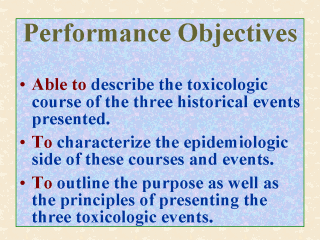| front |1 |2 |3 |4 |5 |6 |7 |8 |9 |10 |11 |12 |13 |14 |15 |16 |17 |18 |19 |20 |21 |review |
 |
As with the last
lecture, at the end of this lecture, students should be able to outline the epidemiologic
incidents and the toxicologic events for each of the three case studies presented here.
Each case has had a course of actions or incidents that sets its history. Students should
also be able to characterize the epidemiologic information that is deemed critical to the
events. Although some epidemiologic information cannot bring a toxicologic event to a
closure, at the minimum it would narrow the knowledge gaps that otherwise cannot be
completely filled with toxicology studies alone. In addition, students should contrast the various impacts made by the epidemiologic information on these toxicologic events, and be able to conceptualize the difference in these impacts. Insofar as the same type or the same level of epidemiologic information is not always needed or readily attainable, the importance and relevance of epidemiologic information to a toxicologic event necessarily varies with the situation involved. Finally, students should be able to appreciate the purpose for which the three case studies were presented in this lecture. There are numerous toxicologic events in history. The case studies were purposely selected to represent certain important concepts and principles which were highlighted in the slides labeled The Lesson (that to be learned). |